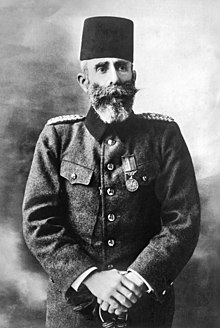Mahmud Shevket | |
|---|---|
 | |
| Grand Vizier of the Ottoman Empire | |
| In office 23 January 1913 – 11 June 1913 | |
| Monarch | Mehmed V |
| Preceded by | Kâmil Pasha |
| Succeeded by | Said Halim Pasha |
| Minister of War | |
| In office 23 January 1913 – 11 June 1913 | |
| Monarch | Mehmed V |
| Grand Vizier | Himself |
| Preceded by | Nazım Pasha |
| Succeeded by | Ahmet İzzet Pasha |
| In office 12 January 1910 – 9 July 1912 | |
| Monarch | Mehmed V |
| Grand Vizier | İbrahim Hakkı Pasha Mehmed Said Pasha |
| Preceded by | Salih Hulusi Pasha |
| Succeeded by | Hurşid Pasha |
| Personal details | |
| Born | 1856 Baghdad, Baghdad Eyalet, Ottoman Empire |
| Died | 11 June 1913 (aged 56 or 57) Istanbul, Ottoman Empire |
| Manner of death | Assassination |
| Resting place | Monument of Liberty, Istanbul |
| Relations | Khaled Sulayman Faiq (brother), Hikmet Sulayman (brother) |
| Alma mater | Mekteb-i Harbiye |
| Military service | |
| Allegiance | |
| Branch/service | |
| Rank | Field Marshal |
| Commands | Third Army Action Army |
| Battles/wars | Macedonian Struggle 31 March Incident Albanian Revolt of 1910 Yemeni Revolt Albanian Revolt of 1912 First Balkan War |
Mahmud Shevket Pasha (Ottoman Turkish: محمود شوكت پاشا, 1856 – 11 June 1913)[1] was an Ottoman military commander and statesman.
During the 31 March Incident, Shevket Pasha and the Committee of Union and Progress overthrew Abdul Hamid II after an anti-Constitutionalist uprising in Constantinople.[2] He played the role of a military dictator, surpassing the power of the CUP and the Grand Viziers after the crisis. As War Minister he played a leading role in military reform and the establishment of Air Divisions. Shevket Pasha became Grand Vizier during the First Balkan War in the aftermath of the 1913 coup d'état, from 23 January 1913 until his death by assassination.
- ^ David Kenneth Fieldhouse: Western imperialism in the Middle East 1914-1958. Oxford University Press, 2006 p.17
- ^ Urazov, Fatikh. Generalissimusy mira XVI-XX vekov [Istoricheskiye portrety]. p. 58. ISBN 5-295-01270-0.